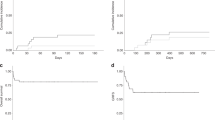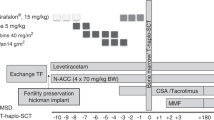Abstract
BMT is curative in almost 75% of children affected by severe primary immunodeficiencies (PIDs). Recently, the chance of cure has increased thanks to the availability of matched unrelated donors (MUDs). Nevertheless, besides the conventional indications to BMT (profound or absent T-cell function, profound or absent natural killer function, known syndromes with T-cell deficiencies), indications to BMT for PIDs affecting the quality of life or having an expectation of life that does not exceed the third-fourth decade remain unclear. Infact, if it is evident that the survival rate in an infant grafted for a PID with a MUD is expected to be more than 80%, alternative treatments such as gene therapy are now available.
This is a preview of subscription content, access via your institution
Access options
Subscribe to this journal
Receive 12 print issues and online access
$259.00 per year
only $21.58 per issue
Buy this article
- Purchase on Springer Link
- Instant access to full article PDF
Prices may be subject to local taxes which are calculated during checkout






Similar content being viewed by others
References
Porta F, Friedrich W . Bone marrow transplantation in congenital immunodeficiency diseases. Bone Marrow Transplant 1998; 21 (Suppl 2): S21–S23. Review.
Bertand Y, Landais P, Friedrich W, Gerritsen B, Morgan G, Fasth A et al. Influence of severe combined immunodeficiency phenotype on the outcome of HLA non-identical, T-cell-depleted bone marrow transplantation: a retrospective European survey from the European group for blood and marrow transplantation and the European society for immunodeficiency. J Pediatr 1999; 134: 740–748.
Lanfranchi A, Verardi R, Tettoni K, Neva A, Mazzolari E, Pennacchi M et al. Haploidentical peripheral blood and marrow stem cell transplantation in nine cases of primary immunodeficiency. Haematologica 2000; 85: 41–46.
Seger RA, Gungor T, Belohradsky BH, Blanche S, Bordigoni P, Di Bartolomeo P et al. Treatment of chronic granulomatous disease with myeloablative conditioning and an unmodified hemopoietic allograft: a survey of the European experience, 1985–2000. Blood 2002; 100: 4344–4350. Review.
Driesse GJ, Gerritsen EJ, Fischer A, Fasth A, Hop WC, Veys P et al. Long-term outcome of haematopoietic stem cell transplantation in autosomal recessive osteopetrosis: an EBMT report. Bone Marrow Transplant 2003; 32: 657–663.
Bartolome J, Porta F, Lanfranchi A, Rodriguez-Molina JJ, Cela E, Cantalejo A et al. B cell function after haploidentical in utero bone marrow transplantation in a patient with severe combined immunodeficiency. Bone Marrow Transplant 2002; 29: 625–628.
Pirovano S, Notarangelo LD, Malacarne F, Mazzolari E, Porta F, Lanfranchi A et al. Reconstitution of T-cell compartment after in utero stem cell transplantation: analysis of T-cell repertoire and thymic output. Haematologica 2004; 89: 450–461.
Mazzolari E, Moshous D, Forino C, De Martiis D, Offer C, Lanfranchi A et al. Hematopoietic stem cell transplantation in Omenn syndrome: a single-center experience. Bone Marrow Transplant 2005; 36: 107–114.
Grunebaum E, Mazzolari E, Porta F, Dallera D, Atkinson A, Reid B et al. Bone marrow transplantation for severe combined immune deficiency. JAMA 2006; 295: 508–518.
Pai SY, DeMartiis D, Forino C, Cavagnini S, Lanfranchi A, Giliani S et al. Stem cell transplantation for the Wiskott–Aldrich Syndrome: a single-centre experience confirms efficacy of matched unrelated transplantation. Bone Marrow Transplant 2006; 38: 671–679.
Author information
Authors and Affiliations
Corresponding author
Rights and permissions
About this article
Cite this article
Porta, F., Forino, C., De Martiis, D. et al. Stem cell transplantation for primary immunodeficiencies. Bone Marrow Transplant 41 (Suppl 2), S83–S86 (2008). https://doi.org/10.1038/bmt.2008.61
Published:
Issue Date:
DOI: https://doi.org/10.1038/bmt.2008.61
Keywords
This article is cited by
-
HLA-haploidentical donor transplants with post-transplant cyclophosphamide in children with primary immune deficiency disorders
Bone Marrow Transplantation (2022)
-
Longitudinal Evaluation of Immune Reconstitution and B-cell Function After Hematopoietic Cell Transplantation for Primary Immunodeficiency
Journal of Clinical Immunology (2015)



